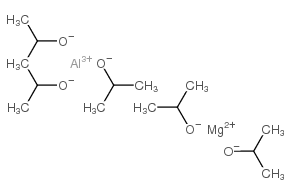69207-83-6
| Name | Aluminum magnesium isopropoxide |
|---|---|
| Synonyms |
aluminum magnesium isopropoxide, 99.95+% (metals basis)
MFCD00070426 |
| Density | 1.035 g/cm3 |
|---|---|
| Boiling Point | 110ºC (5 torr) |
| Melting Point | 40-40ºC |
| Molecular Formula | C15H38AlMgO5 |
| Molecular Weight | 349.74600 |
| Flash Point | 130-142°C/2.0mm |
| Exact Mass | 349.23900 |
| PSA | 115.30000 |
| LogP | 4.46400 |
| Appearance | Liquid | Colorless |
| Water Solubility | Not miscible with water. |
|
Section 1: Product Identification Chemical Name:Magnesium aluminum i-propoxide(99.99%-Mg) PURATREM CAS Registry Number:69207-83-6 Formula:MgAl2(OC3H7)8 EINECS Number:not available Chemical Family:metal alkoxide Synonym:Aluminum magnesium isopropoxide
Section 2: Composition and Information on Ingredients IngredientCAS NumberPercentACGIH (TWA)OSHA (PEL) Title Compound69207-83-6100%10mg/m3 (as Al2O3)no data Section 3: Hazards Identification The dust may moderately irritate the skin, eyes, and respiratory system. Moisture will produce isopropanol Emergency Overview: vapor which may cause drowsiness. Primary Routes of Exposure:Inhalation, ingestion, contact with skin and eyes. Eye Contact:May cause moderate irritation of the eyes. Skin Contact:Dehydrating agent. Liquid may cause mild irritation of the skin. Isopropanol vapor may be irritating to the nose and respiratory tract and cause headache, dizziness, and Inhalation: drowsiness. Ingestion:Ingestion may cause gastrointestinal distress, dizziness, weakness, and drowsiness. The dust may moderately irritate the skin, eyes, and respiratory system. Moisture will produce isopropanol Acute Health Affects: vapor which may cause drowsiness. In animal studies isopropanol has acted as a mutagen, tumorigen and reproductive effector. Prolonged Chronic Health Affects: exposure can damage nerves, kidneys, and the cardiovascular system. NTP:No IARC:No OSHA:No SECTION 4: First Aid Measures Immediately flush the eyes with copious amounts of water for at least 10-15 minutes. A victim may need Eye Exposure: assistance in keeping their eye lids open. Get immediate medical attention. Wash the affected area with soap and water. Remove contaminated clothes if necessary. Seek medical Skin Exposure: assistance if irritation persists. Remove the victim to fresh air. Closely monitor the victim for signs of respiratory problems, such as difficulty Inhalation: in breathing, coughing, wheezing, or pain. In such cases seek immediate medical assistance. Ingestion:Seek medical attention immediately. Keep the victim calm. Give the victim water (only if conscious). SECTION 5: Fire Fighting Measures Flash Point:not applicable Autoignition Temperature:no data Explosion Limits:no data Extinguishing Medium:carbon dioxide, dry powder or foam If involved in a fire, fire fighters should be equipped with a NIOSH approved positive pressure self-contained Special Fire Fighting Procedures: breathing apparatus and full protective clothing. Hazardous Combustion andIf involved in a fire this material may emit toxic organic fumes and alumina and magnesia dust. Decomposion Products: Unusual Fire or Explosion Hazards: Highly flammable material. Dust may form explosive mixtures with air. SECTION 6: Accidental Release Measures Eliminate all ignition sources. Avoid contact with water. Small spills may be adsorbed into diatomaceous earth, Spill and Leak Procedures: sand, or other suitable adsorbent, and swept up. SECTION 7: Handling and Storage Store in a tightly sealed container in a cool dry place. If container is left open, product may adsorb moisture Handling and Storage: and carbon dioxide from the atmosphere and release isopropanol vapor. SECTION 8: Exposure Controls and Personal Protection Eye Protection:Always wear approved safety glasses when handling a chemical substance in the laboratory. Skin Protection:Wear protective clothing and gloves. Ventilation:Material may form a vapor upon exposure to air. if possible, handle the material in an efficient fume hood. If ventilation is not available a respirator should be worn. The use of respirators requires a Respirator Respirator: Protection Program to be in compliance with 29 CFR 1910.134. Ventilation:Material may form a vapor upon exposure to air. if possible, handle the material in an efficient fume hood. Additional Protection:No additional protection required. SECTION 9: Physical and Chemical Properties Color and Form:white xtl Molecular Weight:550.97 Melting Point:40° Boiling Point:110°C/5 mm Vapor Pressure:no data Specific Gravity:no data Odor:alcohol-like odor Solubility in Water:Reacts with water SECTION 10: Stability and Reactivity Stability:moisture sensitive Hazardous Polymerization:no hazardous polymerization Conditions to Avoid:Keep away from moisture, heat and ignition sources including open flame and electrostatic discharge. Incompatibility:Water, oxidizing agents, and halogens Decomposition Products:Carbon dioxide, carbon monoxide, organic vapors, soot, and metal oxides and carbonates. SECTION 11: Toxicological Information RTECS Data:No information available in the RTECS files. Carcinogenic Effects:No data available Mutagenic Effects:No data available Tetratogenic Effects:No data available SECTION 12: Ecological Information Ecological Information:No information available SECTION 13: Disposal Considerations Disposal:Dispose of according to local, state and federal regulations. SECTION 14: Transportation Shipping Name (CFR):Flammable solids, Organic, N.O.S. Hazard Class (CFR):4.1 Additional Hazard Class (CFR):NA Packaging Group (CFR):II UN ID Number (CFR):UN# 1325 Shipping Name (IATA):Flammable solid, Organic, N.O.S. Hazard Class (IATA):4.1 Additional Hazard Class (IATA):NA Packaging Group (IATA):II UN ID Number (IATA):UN# 1325 SECTION 15: Regulatory Information TSCA:Not listed in the TSCA inventory. SARA (Title 313):Not reportable under SARA section 313. Second Ingredient:none SECTION 16 - ADDITIONAL INFORMATION N/A |
| Risk Phrases | 11-14-36/37/38 |
|---|---|
| Safety Phrases | 8-16 |
| RIDADR | UN 3205 |
| Packaging Group | II |
